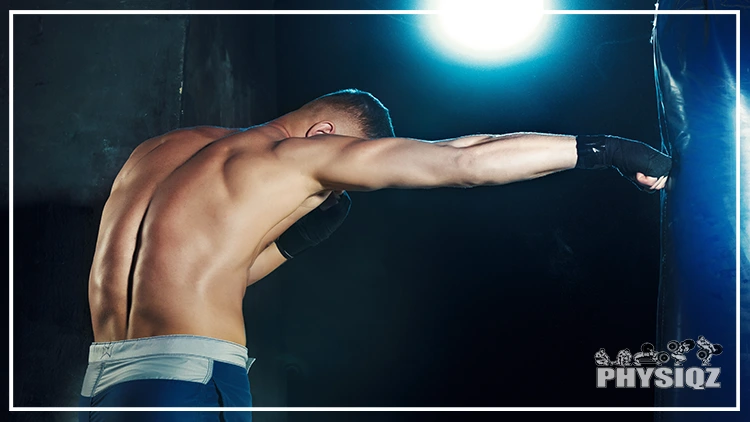
In recent years, the question of which muscles boxing works has become increasingly common. As a full-body exercise, boxing engages a variety of muscles, including those in the core, upper and lower back, arms, chest, shoulders, and most lower body areas like the glutes, quads, hamstrings, calves, and hips.1
And as seen below, each one of these body parts have countless muscles that make up each.
Boxing can place the entire body under quite a bit of stress and this stress mainly appears in the form of developing better upper body musculature and cardiovascular endurance.
However, because boxing does not effectively place the body under progressively increasing stress, progressive overload never occurs, making boxing ineffective for building muscle week over week, or year over year.
That being said, boxing is highly effective for activating the vast majority of the muscles in the body, and more often than not, those who box are in better shape than those who don’t lift weights or box.
To understand why this is the case, let’s first take a look into how boxing affects the different muscle groups of the human body.
Muscles Engaged in Boxing: Which Muscles Are Activated During Boxing?
When considering the muscles engaged in boxing, the vast majority of the body is used. Intuitively, movements like punching, ducking and weaving all require the upper body and lower body to work in tandem in order to deliver forceful punches as well as avoid counters.
Overall, the trap bar deadlift muscles worked, close grip lat pulldown muscles worked, and reverse curl muscles worked are similar to those worked in boxing since they all involve the upper body, but to a different extent.
Let’s begin by discussing what muscles does punching work.
Upper Body: Core, Upper Back, Arms, Chest, Shoulders, & Lower Back
When boxing, the upper body’s musculature has to work in tandem in order to effectively deliver force while also receiving it. The shoulders and chest help to stabilize the upper arms and require good strength and mobility in order to ensure safety when punching, while the back and core function more as stabilizing muscle groups to keep the lower back safe.
Core
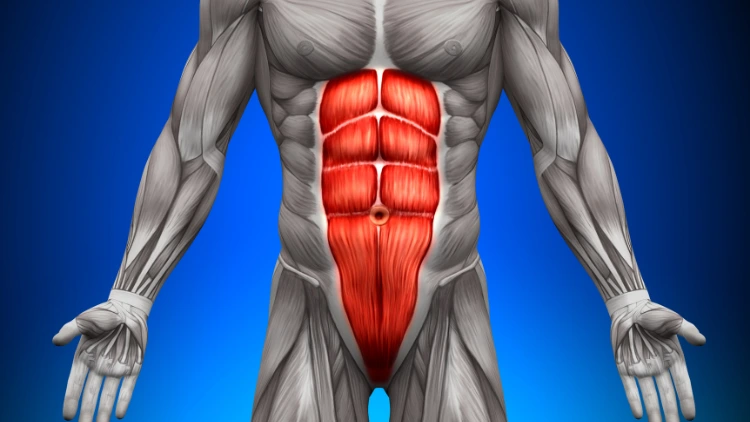
Source: decade3d via Canva.com2
Boxing is one of the most effective exercises for developing core strength and stability because the transverse abdominis, obliques, and rectus abdominis are constantly being engaged when boxing.
The constant tension on the core means that boxing may be a good exercise to work on training the core, even with bad ab genetics.
Keeping the core flexed and stabilized when boxing is crucial to ensuring that the lower back is kept in a safe position.
It is also the ‘bridge’ between the upper body and the lower body, meaning that with proper core engagement, any force produced from the lower body musculature will be effectively transferred through the abs.
All this is meant to say is that a strong core will heavily contribute to a boxer’s punching power and overall mobility.
Upper Back
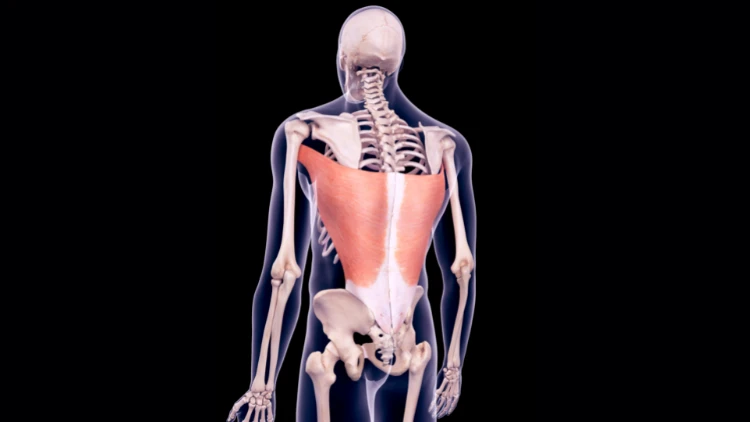
Source: Science Photo Library via Canva.com3
Every single time a boxer punches, the back muscles are stretched to generate force through the body. The lats, traps, rhomboids, and rotator cuff are heavily engaged not only help to generate force in the body but also to help keep the scapula in a retracted, safe position to prevent the boxer from injuring their arms.
Regardless, these muscles are not taken through a large range of motion when punching, so developing strength in these areas does not usually occur from punching or boxing in general, even if they do get activated.
Arms
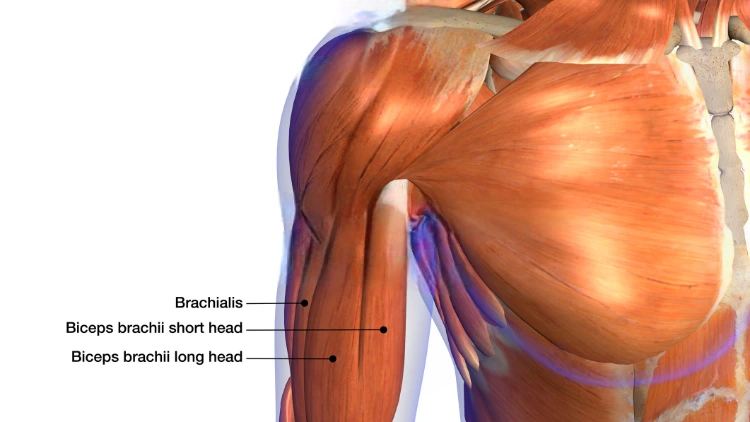
Source: Hank Grebe via Canva.com4
It should go without being said that boxing requires punching, which requires arms. When it comes to what muscles are used in a punch, the biceps, triceps, and forearms are constantly being engaged in order to generate force and propel the fist forward, all while maintaining the aforementioned core and back stability.
Specifically, when it comes to punching, the primary arm muscles being engaged are the triceps, which are activated when the arm is extended.
The biceps, on the other hand, are minimally activated when boxing, making it a poor exercise to use when trying to develop bigger biceps, especially when a person has bad bicep genetics.
Chest
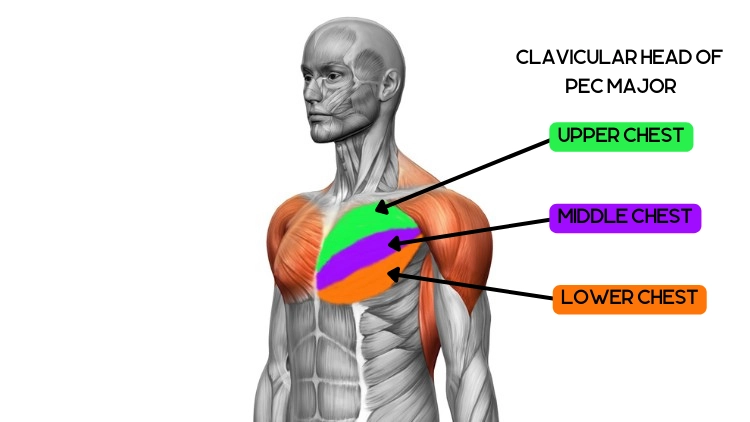
Source: Science Photo Library via Canva.com5
The chest muscles, including the pectoralis major and minor, serve an important role in boxing since their main role is to flex and abduct the arms. More specifically, the pecs push the arms forward and bring them closer together, a motion that should sound familiar.
That is what happens during every single punch, so by helping to stabilize punches while also providing power behind each strike, the chest muscles are crucial when it comes to delivering forceful punches.
Luckily, since the pecs are such a large muscle group, it is quite rare for injuries to occur in the chest from boxing, but it also means that it is one of the main muscle groups activated to produce force when punching. Even still, boxing is not the most effective way of out-training bad chest genetics, mainly for the reasons mentioned above: there is an insufficient amount of progressive overload on the muscles used when boxing, leaving them incapable of growing effectively.
Shoulders
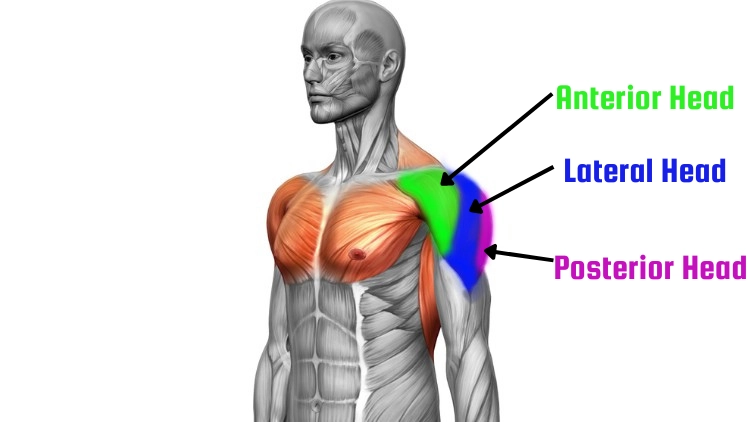
Source: Science Photo Library via Canva.com5
The shoulders, due to the nature of the shoulder joint, are crucial in boxing. The joint itself is the least stable of all joints in the body, and considering the shoulder connects the arms to the torso, force that is generated from the chest, back, and abs are partially sent through the shoulder to the arms to punch.
So, having good shoulder mobility is immensely important to help provide stabilization when punching and also deliver tremendous power with all strikes.
If the shoulders are not properly retracted when boxing, the shoulder joint can easily be damaged from throwing too hard of a punch. Even still, boxing does not actively take the shoulder through its full range of motion, so growing any of the three deltoid heads – front, rear, or lateral – is difficult.
Still, proper punching technique keeps in mind that the shoulder can be hurt if done incorrectly; make sure to keep this in mind, especially if one has bad shoulder genetics.
This means that ample training in shoulder mobility is crucial when trying to develop a long-term boxing career. By doing so, boxers can strengthen the connective tissue other than muscle that resides in and around the shoulder, making them less prone to injury than people who don’t actively do so.
To sum it up, for those wondering, “can boxing develop shoulder muscles”, the answer is not really, but punching with great force will have a large impact on the health of the shoulder overall.
Lower Back
When boxing, the lower back, also known as the erector spinae muscles, are used more than the average person would expect. Think about it this way: when boxing, the body frequently has to twist back and forth, occasionally receiving punches that have to be stabilized by the lower back.
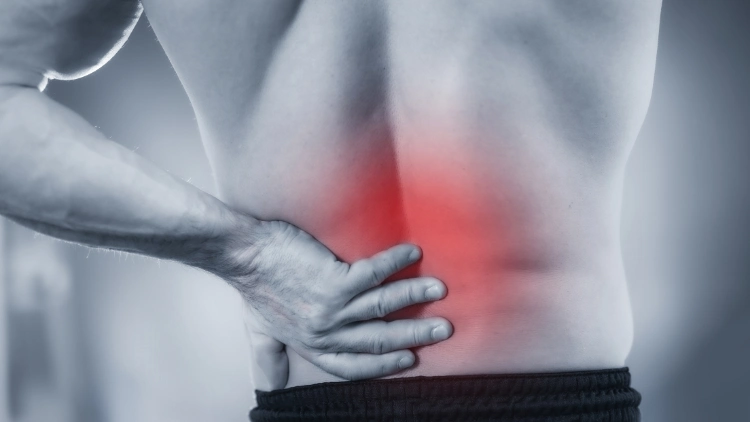
Source: microgen via Canva.com6
Interestingly enough, newer boxers seem to use their lower back muscles less than they should for optimal force when punching, according to a study published in 2011.7
This suggests that to become a better boxer, focusing on driving force through the lower back, and keeping it stable all while boxing, is a good idea to develop a stronger punch.
Lower Body: Glutes, Quads, Hamstrings, Calves, & Hips
When it comes to the muscles worked in boxing, the lower body is also engaged, but to a lesser extent.
Obviously, these muscles will be used substantially more when kickboxing, but in traditional boxing, they are mainly ‘used’ in order to keep the body moving and dancing around the ring.
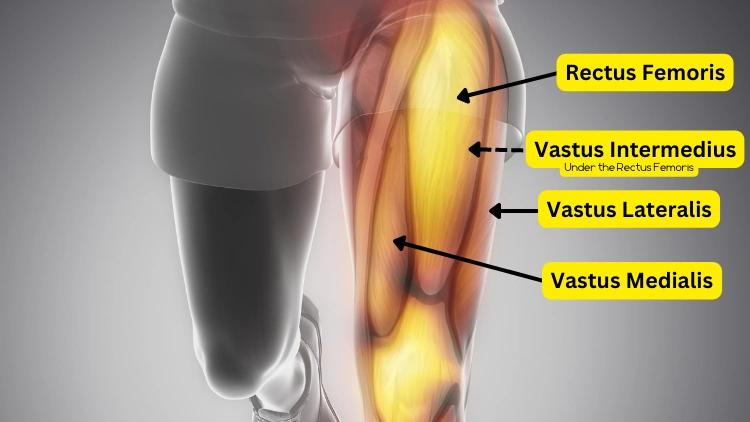
Source: janulla via Canva.com8
But when it comes to what muscle groups you should work together when boxing, the lower body is extremely important to use in tandem with the upper body.
Glutes
The glute muscles are constantly engaged in boxing to provide stability when moving around the ring and rotating laterally. Moving from side to side also requires the glutes to be flexed in order to stabilize the pelvis and prevent the lower back from rounding.
They also work in tandem with the lower back to ensure that the pelvis is stabilized — any sort of pelvic or upper body rotation will require the glutes to be stretched to some extent, so the glutes are frequently used when boxing.
However, similar to most muscles used when boxing, the glutes are not actively taken through a full range of motion. For the glutes to be maximally stretched, think of the hip thrust.
In the hip thrust, a person sits on the ground with their upper back placed against a bench, thrusting their glutes straight up to full extension, and stretching them all the way back down to the ground at the bottom of the rep. This is what is known as full glute extension.
But when boxing, this level of stretch is never actually reached, so boxing is not a good training style for progressively overloading the glutes.
Quads
The quadriceps muscles are used to generate forward momentum during boxing and help absorb the impact of each punch thrown. Similar to the glutes, the quads mainly help to stabilize the upper body, but as aforementioned, can help to develop momentum to get a strong punch in.
One thing to note is that the quads are usually not actively extended when boxing. Compared to a leg extension machine, for example, the quads never really progress through their full range of motion when boxing since the knee rarely bends into partial or even full flexion.
Effectively, when boxing, the quads will never have a substantial amount of progressive overload placed on them, but they are still used to help produce force when punching. It should go without being said that working on out-training bad leg genetics through boxing is an ineffective strategy.
Hamstrings
The hamstrings play an important role in providing power when throwing punches. The hamstring’s main function is to lift the foot towards the glutes which means they are important for anything that involves knee flexion.
Ultimately, they assist the lower back, quads, and calves to push force through the feet into the upper body.
The hamstrings are also used to help keep the lower back extended. Many bodybuilders and boxers who have tight hamstrings tend to have rounded lower backs, which can have the dangerous effect of leaving the spine in a disadvantageous position.
This is a commonly seen phenomenon in the modern day — people who work at a desk for the majority of the day have tight hamstrings due to sitting, which then leads to lower back rounding and causing back pain.
Regardless, similar to the quads, the hamstrings are never taken through their full range of motion when boxing, as they are semi-extended when standing in the ring. But, good boxers will be able to use their lower body muscles in tandem to help produce force, as well as to stabilize their lower back.
Calves
The calves are also heavily engaged during boxing in order to provide stability and push-off power when moving around the ring. Most boxes bounce around the ring on the ball of their foot in order to stay agile, which, by default, has the effect of flexing their calves.
This means that force will be pushed all the way up from the feet, through the calves, to the arms when punching. So, using the calves as a way to produce force is quite common in boxing, but they are primarily used when getting around the ring.
Hips
Boxers often rely on their hip flexors and abductors when throwing punches in order to generate power and stability. The hips are also used when throwing hooks, jabs, and uppercuts in order to generate enough momentum to ensure a powerful strike.
Tight hip flexors, similar to weak glute muscles, can make it difficult for the body to rotate effectively, leaving the lower back in a more compromised position.
Boxers will typically include stretching in their workout regimens in order to ensure that their lower body muscles can stretch and accommodate force from a variety of angles and positions. Making sure to stretch the lower body is crucial before boxing.
In conclusion, while boxing is an effective way to activate the majority of the muscles in the body, it is not the most efficient form of exercise for building muscle. It can still be an excellent addition to any fitness routine, as it provides a fantastic cardiovascular workout.
Can Boxing Build Muscle? Should You Box To Build Muscle?
The answer to whether boxing builds muscle is both yes and no. While boxing can help develop muscle, it is not the most efficient form of exercise for muscle building.
Boxing does not provide enough resistance to effectively build some mass and maintain muscle. It can still be an effective form of exercise for developing endurance in the lungs and will help the entire body to take on stress for long periods.
Overall, boxing is ineffective for building muscle because it lacks the ability to progressively overload muscles. Progressive overload is the concept of gradually increasing resistance to a muscle group in order for it to grow and develop.
Without progressive overload, muscle growth is quite difficult to achieve for one main reason: the muscle has already adapted to the weights it has been using.
Of course, boxers can use weighted gloves to train, but that’s usually more for developing greater agility rather than building muscle.
The body’s muscles are extremely intelligent — when a stimulus is placed upon them, they will break down and repair in order to become strong enough to easily deal with the stimulus. But, if the stimulus is not increased over time, research shows that the muscles will not continue to grow.9
This is why it is called ‘progressive’ overload – the muscles are overloaded over a long period of time, increasing the weights, repetitions, or sets in order to ‘overload’ the muscles.
Specifically, in regard to aerobic sports like boxing, there is not much room for progressive overload to occur.
Just think about it logically — the only kind of counter-force that is ever being relayed against the body when boxing is when a punch lands on the boxer themself or they land a punch on the opposing boxer.
But there is minimal muscle stretch, contraction, or even resistance that is faced in either situation.
While boxing works essentially all the muscles in the body, the absence of counter forces in punching and footwork prevents effective progressive overload, limiting the ability to build muscle strength over time.
Though, keep in mind that other types of aerobic exercise can be progressively overloaded to develop better endurance.
For example, treadmill running intensity can be incrementally scaled up in order to develop a greater VO2 max, the maximum amount of oxygen that can be used by the body in exercise; compared to boxing, which is extremely difficult to ‘overload’, using a treadmill is an easy way to progressively overload cardiovascular endurance.10
Benefits of Boxing
Even though it has been established that the answer to the question of whether boxing builds muscle is no, there are still numerous benefits to boxing.
Improved Cardiovascular Health & Endurance (& Burn Calories Quickly)
When a person is throwing punches and dodging what the other boxer is countering back with, the body is using a ton of energy to maintain that activity. This requires a person’s heart to pump significantly harder while simultaneously forcing them to use more oxygen compared to when at rest.
This forces the body to adapt and become more efficient with its current capacity for oxygen, leading to improved blood flow to different parts of the body and, obviously, a greater lung capacity over a long period of time.
Research shows that increasing punching tempo while boxing is also beneficial for increasing heart rate and developing greater efficiency when taking air in and breathing it out, meaning that there is a scaling cardiovascular stimulus when boxing based on intensity.11
What this means overall is that boxing is a fantastic addition to a workout routine as cardio. Boxing will train technical skills and movements required in a very movement-based sport while, as aforementioned, increasing heart rate and forcing the body to be able to use less oxygen while providing the same output.
The only thing to keep in mind here is that for a person who is bulking, long boxing sessions could potentially lead to getting into a caloric deficit, so make sure to eat more food if this is the case.
Increased Coordination & Balance
Boxing requires the boxer to be extremely in sync with their body so that they can duck, weave, punch, and avoid punches.
Without a great deal of coordination, balance, and agility in order to move effectively, it is quite difficult to consciously think about how to do so in the ring since there is the pressure of both the clock and the other boxer, meaning hundreds of repetitions of boxing movements are necessary to allow the body to physically operate on autopilot when actually in the ring.
This degree of coordination is easily transferable to other sports and life in general, leading to many boxers having fluid biomechanics when walking.
That seems like an odd thing to mention, but consider any person that seems to just walk effortlessly — these people tend to be athletes of some sort who have clearly mastered their body’s most basic biomechanics.
Enhanced Mental Toughness & Focus
Boxing is a mental sport as well as a physical one. A boxer needs to stay focused throughout their fight and maintain maximum concentration even when their energy reserves are nil or when they are internally panicking.
This trains the mind to stay focused and persevere even when things get tough, which is a valuable skill to have in both an intense sport like boxing, and life in general.
Furthermore, boxing teaches a person to maintain an iron grip on their nerves since the boxer must remain calm and focused in the ring even while facing a tough opponent. This is something that can easily be translated to other avenues of life, as it will help build confidence and composure during stressful times.
Reduced Stress Levels
While there isn’t research on boxing specifically that says it is a good way to release stress, there are consistent findings that aerobic exercise, like boxing, can have profound effects on people, leaving them feeling calm for several hours post-exercise.12
Even a 20 to 30-minute session can have these effects, so using boxing toward the end of one’s day can be highly beneficial to relieve any stress from earlier on.
Or, it can be used as a way to start the day. A potential routine could be waking up, stretching, and doing a bit of shadowboxing for 10 to 15 minutes to get blood flowing and zone into the feeling of being in the body.
For those without access to punching bags, making use of punching bag alternatives such as old car tires are just as beneficial.
In general, any sort of morning physical routine will help people to stay in the present moment, allowing them to attain greater focus, clarity, and remain calm going into their day.
Increased Agility, Flexibility, & Speed
One should be able to intuitively gather that the more a person boxes, the more agile, flexible, and quick they will become. As mentioned earlier, when a boxer is throwing punches and dodging in and out of them simultaneously, the body is using a ton of energy to maintain constant movement.
This means that not only is the person’s heart rate increasing but their reflexes and agility are also being frequently challenged. By default, the human brain and body love to adapt to new forms of stimuli, so the more time a person spends in or training to be in the ring, the greater the coordination increases.
By moving quickly in and out of range of their opponent’s punches, a boxer trains their body to move quickly and with force, which can also translate to increased agility and flexibility in other sports.
Furthermore, the speed at which a boxer needs to throw punches can increase explosiveness which can be extremely beneficial in a number of other sports.
Overall, boxing is a great form of exercise that can provide the body with a great range of benefits, from improving cardiovascular health to increasing mental toughness. It is a sport that requires intense focus and control, which can be very beneficial in other areas of life. It is also great for relieving stress and increasing agility, flexibility, and speed.
Muscles of Boxers vs Normal People vs Bodybuilders
To better understand how boxing can help a person get into better shape or develop muscles, let’s take a look at three random well-known people who fit into the category of either boxer, ‘normal’ person (non-weightlifter or boxer), or weightlifter.
Arm Muscles of Muhammad Ali Who Was a Professional Boxer
Muhammad Ali, who was a professional boxer, had excellent arm muscles that were very well-developed from all the training he underwent. His biceps and triceps were both very defined due to his intense boxing workouts, which included a lot of punching drills and heavy bag work.
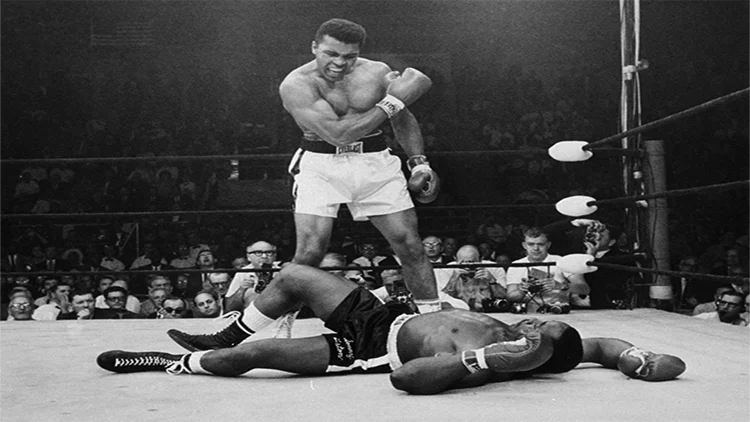
Source: NBC News13
He also had great shoulder muscles due to the various exercises he did in order to improve his posture and increase shoulder stability when throwing punches.
But, keep in mind — Muhammad Ali did not actually lift weights.
He had an extremely well-defined body because he did lots of bodyweight exercises, like jump ropes, shadowboxing, and running, but most of his muscular definition came from being lean, having a strict diet, and regularly boxing, reiterating that boxing alone does not build muscle.
Many weightlifters or people who don’t box often would be quite surprised by this — Ali did literally zero form of weightlifting.
Of course, he may have dabbled at some point in his life, but even still, developing a strong and lean body through boxing is clearly possible, and it is a good way to learn to effortlessly lose weight, getting into a 1000 calorie deficit.
Mike Israetel Arm Muscles (Bodybuilder)
Mike Israetel, a famous bodybuilder and public figure who produces quite a bit of information-dense weightlifting-related content, is known for having large, well-defined arm muscles. His arms are extremely muscular because of his many years of weightlifting experience and very strict diet regime.
He also does lots of exercises specifically designed to target the biceps, triceps, and shoulders like curls, rows, and overhead presses.
The difference between a bodybuilder’s arm muscles and boxers is that the bodybuilder focuses more on heavy lifting to increase muscle size, whereas a boxer needs to focus on exercises that will increase their speed, agility, and explosiveness while also keeping the overall mobility of their joints as a priority.
A bodybuilder, on the other hand, does not need to worry about punching, so the exercises they do are often focused on building strength and size.
Keep in mind that using weight training for hypertrophy and strength requires different programming. Modern studies suggest that using a higher rep range from 6-15 repetitions is more effective for building larger muscles, while lower rep ranges of 1-5 are more effective for strength building.14
To reiterate what has been aforementioned even further, since the above study shows that rep ranges of 1-15 are optimal for building strength and muscle, let’s draw a comparison to boxing.
There will always be at least 15 repetitions of a specific movement in a boxing match, and the maximum resistance that challenges a boxer’s muscles, leading to hypertrophy or strength gain, occurs consistently throughout the match.
Rarely ever, if at all, which is to emphasize that weightlifters, like Mike Israetel, train their muscles in a way that is optimized for growth and strength, but boxers do not.
Arm Muscles of David Hasselhoff (Non-Weightlifter)
Last but not least is David Hasselhoff. He was an actor and singer who was once very popular in the ’80s, but is definitely not a weightlifter.
His arms are not particularly well-defined, as he doesn’t do any heavy lifting or seemingly any form of aerobic workout.
David Hasselhoff’s arm muscles are probably best described as ‘normal’. He does not have huge biceps or triceps, nor is his body lean or defined. This can be attributed to his lack of exercise overall and a diet that probably isn’t as strict as it should be in order to get the biggest muscles.
In conclusion, the arm muscles of professional boxers are much more developed than ‘normal’ people who don’t lift weights or box regularly. Boxers need to focus on exercises that will increase their speed, agility, and explosiveness.
Bodybuilders tend to have larger muscles due to years of heavy weightlifting, but they do not need to worry about being able to throw powerful punches or movements quickly.
This means that while boxing engages many of the body’s muscles, it doesn’t necessarily train them to grow stronger or become larger.
Frequently Asked Questions
Is Boxing Good for Weight Loss? Does Boxing Help To Get a Toned Body?
Yes, boxing is an excellent way to lose weight and get a toned body. Boxing involves intense cardiovascular exercise that helps to burn calories quickly, as well as weight training to help build muscle.
It also requires precision and speed, which helps to develop a substantial amount of coordination; this will ultimately help a person to lean out, but ultimately, the answer to “does boxing build muscle” is still not really.
Does a Boxing Bag Work the Same Muscles As Sparring?
No, a boxing bag does not work the same muscles as sparring another boxer. While the focus of boxing bag work is on punching power and speed, sparring involves much more than just hitting the opponent.
Sparring requires quick reflexes, agility, and even thinking ahead to anticipate an opponent’s movements as well as a hefty amount of footwork. Training with a boxing bag and a sparring partner will help develop different skills, but a boxing bag will ultimately be better for developing punching, while sparring is best for developing holistic boxing skills.
What Muscles Does Boxing Work When Using Weighted Gloves?
Using weighted gloves during boxing can be beneficial for developing more strength in the arms and will also help to improve agility. Weighted gloves increase the resistance of each punch, forcing the arm muscles to work harder in order to generate power.
This can help to strengthen the biceps, triceps, shoulders, and even the chest muscles. Additionally, practicing with weighted gloves helps to improve punching speed since there is a bit more of a counter-force when lifting the arms
References
1“Free Photo | Male boxer boxing in punching bag.” Freepik. Accessed 20 April 2023. <https://www.freepik.com/free-photo/male-boxer-boxing-punching-bag_9159790.htm>
2decade3d. Canva. Accessed 20 April 2023. <https://www.canva.com/photos/MADerFwn3js-abs-anatomy-muscles/>
3Science Photo Library. “F017/1255.” Canva. Accessed 12 April 2023. <https://www.canva.com/photos/MADq3vbyn-k-f017-1255/>
4“Labeled Anatomy Chart of Neck and Shoulder Muscles on White Background – Photos by Canva.” Canva. Accessed 20 Apr. 2023. <https://www.canva.com/photos/MADZASGJL7w-labeled-anatomy-chart-of-neck-and-shoulder-muscles-on-white-background>
5Science Photo Library. “The muscles involved in standing biceps curl. The stabilizing muscles are highlighted.” Canva. Accessed 12 April 2023. <https://www.canva.com/photos/MADmTGwAFbo-the-muscles-involved-in-standing-biceps-curl-the-stabilizing-muscles-are-highlighted-/>
6microgen. Canva. Accessed 20 April 2023. <https://www.canva.com/photos/MADm1DXjhew-lower-back-pain/>
7Zhang, R.-H., & Kang, Z.-X. (2011). [Women boxing athletes’ EMG of upper limbs and lumbar muscles in the training of air striking of straight punch] – PubMed. Zhongguo Ying Yong Sheng Li Xue Za Zhi = Zhongguo Yingyong Shenglixue Zazhi = Chinese Journal of Applied Physiology, 27(2). <https://pubmed.ncbi.nlm.nih.gov/21845888/>
8janulla. Canva. Accessed 20 April 2023. <https://www.canva.com/photos/MADE-Sq7uLk-quadriceps-female-anatomy/>
9Kraemer, W. J., Ratamess, N. A., & French, D. N. (2002). Resistance training for health and performance – PubMed. Current Sports Medicine Reports, 1(3). <https://doi.org/10.1249/00149619-200206000-00007>
10McNicol, A. J., O’Brien, B. J., Paton, C. D., & Knez, W. L. (2009). The effects of increased absolute training intensity on adaptations to endurance exercise training – PubMed. Journal of Science and Medicine in Sport, 12(4). <https://doi.org/10.1016/j.jsams.2008.03.001>
11Kravitz, L., Greene, L., Burkett, Z., & Wongsathikun, J. (2003). Cardiovascular response to punching tempo – PubMed. Journal of Strength and Conditioning Research, 17(1). <https://doi.org/10.1519/1533-4287(2003)017<0104:crtpt>2.0.co;2>
12Jackson, E. (2013, June). STRESS RELIEF: The role of exercise in stress management : ACSM’s health & fitness journal. LWW. <https://journals.lww.com/acsm-healthfitness/fulltext/2013/05000/stress_relief__the_role_of_exercise_in_stress.6.aspx.%C2%A0>
13“Muhammad Ali Dies at Age 74.” NBC News, 4 June 2016. <https://www.nbcnews.com/news/sports/muhammad-ali-greatest-all-time-dead-74-n584776>
14Schoenfeld, B. J. (2010). The mechanisms of muscle hypertrophy and their application to resistance training – PubMed. Journal of Strength and Conditioning Research, 24(10). <https://doi.org/10.1519/JSC.0b013e3181e840f3>